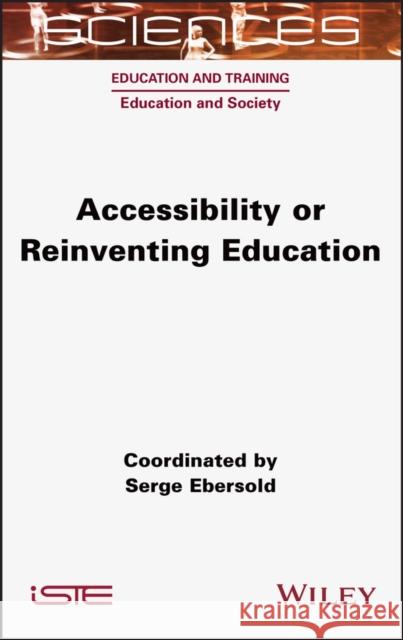Accessibility or Reinventing Education » książka



Accessibility or Reinventing Education
ISBN-13: 9781789450118 / Angielski / Twarda / 2021 / 256 str.
Accessibility or Reinventing Education
ISBN-13: 9781789450118 / Angielski / Twarda / 2021 / 256 str.
(netto: 827,11 VAT: 5%)
Najniższa cena z 30 dni: 731,48 zł
ok. 13-18 dni roboczych.
Darmowa dostawa!
Introduction xiSerge EBERSOLDPart 1. Accessibility as a Societal Imperative 1Chapter 1. The Accessibility Imperative: Outlines and Implications 3Serge EBERSOLD1.1. Introduction 31.2. Accessibility, or school as a social protection vector 41.3. Accessibility, an imperative focused on the ergonomization of practices 71.3.1. Preventing vulnerabilities through a universal approachto accessibility 81.3.2. An integrated approach to accessibility targeting the fight against educational failure 91.3.3. A corrective approach to accessibility aimed at restoring school legitimacy 111.4. An ergonomization of practices related to the fight against institutional discrimination 121.5. Accessibility, or the advent of new forms of normativity 131.6. Conclusion 151.7. References 16Chapter 2. Inclusion and Accessibility: 50 Years of Change 23Peter EVANS2.1. Introduction 232.2. Developing a continuum of support for promoting accessible learning environments 252.3. Developing accessible learning environments; results of international case studies 302.3.1. Recognizing and planning for diversity 302.3.2. Using evaluation for improvement 312.3.3. Professional development of staff 322.3.4. External support services 332.3.5. Within-school services 342.3.6. Co-operation between schools 342.3.7. Parental and community involvement 352.3.8. Whole-school development organization and management strategies 362.3.9. Curriculum development 362.3.10. Classroom organization 372.4. Promoting accountable education systems supporting accessible learning environments 382.5. Conclusion 402.6. References 41Chapter 3. Accessibility Requirements and Evaluation Policies 45Nathalie MONS3.1. Introduction 453.2. New governance of education systems based on performance and social justice 473.3. Evaluation: intellectual movements and political discourse 513.4. Assessment policies and the accessibility imperative 563.5. Conclusion 573.6. References 58Part 2. How Do Schools Meet the Accessibility Imperative? 61Chapter 4. Educational Accessibility: A Catalyst for Innovative Practices 63Michele MAINARDI4.1. Introduction 634.2. The heuristics of innovative teaching practices 644.2.1. The catalytic potential of innovative forces and practices 664.3. School environments and the pedagogical imperative of accessibility 674.3.1. The grouping of learners 674.3.2. The grouping of professionals 694.3.3. The planning of learning and its collocation over time 704.3.4. Pedagogies and assessment practices 734.4. Collaboration and accessibility: beyond "mainstream" and "special" 744.4.1. An emergency condition 764.5. References 77Chapter 5. School Form and Pedagogical and Didactic Accessibilization 81Sylviane FEUILLADIEU, Anne GOMBERT and Hervé BENOIT5.1. Introduction 815.2. Characteristics of the school form 845.3. Practical ways of making school situations more accessible 875.3.1. Study aid gestures 875.3.2. The use of digital tools 895.3.3. Pedagogical and didactic adaptations 915.4. Elements for reflection on a model of analysis of teachers' gestures and postures with a view to accessibilization 945.5. Conclusion 965.6. References 96Chapter 6. The Contribution of ICT to Accessible Learning Environments 99Harald WEBER6.1. Introduction 996.2. Clarifications on the terminology 1006.3. ICT to develop accessible learning environments - more than a purchasing decision 1026.4. Embedding ICT in educational organizations to promote accessible learning environments 1036.5. The transformation of teaching 1086.6. Learners becoming accountable for their learning 1126.7. Conclusion 1146.8. References 114Chapter 7. The Reconfiguration of the Teaching Profession within the Dynamics of Accessibility 117Éric PLAISANCE7.1. Introduction 1177.2. From the "special" professional to the educational accessibility professional 1187.3. A new professionalism that reconfigures teaching legitimacy 1207.4. New dimensions of the profession 1257.5. Teachers' requests and concerns 1277.6. Conclusion: new issues, new questions 1297.7. References 130Part 3. Accessibility, or Reconfiguration of Academic Difficulties 133Chapter 8. Modes of Accessibilization and the Redefinition of Schooling in Accessibility 135Daniel FRANDJI8.1. Introduction 1358.2. Accessibility as a source of democratization through compensatory policies? 1378.3. Accessibility as a source of efficiency and equity, in the name of combating exclusion? 1428.4. Accessibility as a source of inclusion, to maximize opportunities? 1458.4.1. A profusion of categories and devices 1458.4.2. An individualizing and essentializing reading of school productions 1478.4.3. Transformation of the curriculum and school culture 1498.5. Conclusion 1508.6. References 151Chapter 9. Externalized Teaching Units: A Tool for Making School Institutions More Accessible? 155Hugo DUPONT9.1. Introduction 1559.2. Making the school environment more accessible through subcontracting 1579.3. Hierarchical access to the facility 1649.4. Conclusion 1719.5. References 172Chapter 10. Social Figures of Allophony, Approaches to Accessibility and Social Inequalities 175Maïtena ARMAGNAGUE-ROUCHER10.1. Introduction 17510.2. Two approaches to accessibility: a dual staging of school legitimacy 17810.3. The principles of justice underlying the various approaches to school accessibility 18510.4. Conclusion: accessibilization strategies as a source of educational inequalities 19110.5. References 192Chapter 11. The Grammar of Accessibility 195Serge EBERSOLD11.1. Introduction 19511.2. Access as social visibility 19611.2.1. Access as "taking part" 19611.2.2. Access as "being part" 19711.2.3. Access as "acting on" 19811.2.4. Access as a "sense of existing" 20011.3. Accessibility as social legibility 20111.3.1. A finalist approach to the concept of accessibility 20211.3.2. A procedural approach to the concept of accessibility 20311.3.3. An ergonomic approach to the concept of accessibility 20511.4. The concept of accessibilization as social legitimacy 20711.4.1. Accessibilization refers to the institutional legitimization of facilities 20811.4.2. Accessibilization builds upon the legitimization of the schooling process 20911.4.3. Accessibilization results from the driving force of conventions 21111.4.4. Accessibilization is correlated with agents' art of creating 21211.5. Conclusion 21411.6. References 215List of Authors 219Index 221
Serge Ebersold is Professor at CNAM (Conservatoire National des Arts et Metiers), where he holds the Chair on accessibility. From an international perspective, his work links the issue of accessibility to changes in public action, focusing on policies, strategies and practices that lead to accessibility in school and social environments.
1997-2024 DolnySlask.com Agencja Internetowa
KrainaKsiazek.PL - Księgarnia Internetowa









